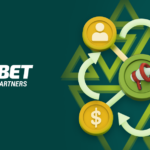From Invisible to Irresistible: A Ground-Up SEO Blueprint for Affiliate Marketers
08.04.2025
From Invisible to Irresistible: A Ground-Up SEO Blueprint for Affiliate Marketers
08.04.2025Chris was stuck. He built an affiliate site, followed SEO rules, and waited for traffic. But nothing happened. No clicks. No sales. Just silence. This article is not another list of SEO tips. It’s a story. A journey from zero to steady income. If you’re an affiliate marketer, this is for you. If you’re tired of chasing Google’s love, this is your path forward.
Meet Chris and SEO for Affiliate Marketing: The Marketer Google Forgot
Chris is a regular person. Not a tech genius. Not a famous influencer. Just someone who wanted to make money online.
He launched his first affiliate site with hope. He picked a niche, wrote product reviews, and used the “right” keywords. He watched YouTube tutorials. He read blog posts. He followed all the advice.
But still, his content didn’t rank. Chris checked Google every day. His pages were on page five. Or not there at all. Even when he typed the exact title, he couldn’t find his site. He tried harder. More posts. More links. Fancy plugins. Still nothing.
It wasn’t just frustrating. It was painful. He saw others getting traffic. He saw shiny dashboards full of earnings. He felt left out. Chris didn’t want to give up. He didn’t want quick wins either. He wanted a real, long-term way to earn. He wanted freedom. He wanted control of his time.
Clicks weren’t enough. He wanted trust. And trust starts with being seen. So he made a choice: to stop chasing tricks and start learning what really works. And that’s where his story begins.
Breaking the Template: Why Standard SEO Doesn’t Work for Affiliates Anymore
Chris thought he was doing it right. Use the keyword. Write 1,500 words. Add a table. Link to Amazon. Repeat. It looked like every other affiliate page. Because it was.
Most affiliates copy the same style. They use the same tools. They follow the same checklists. And they wonder why they don’t rank. Google sees this too. It knows when a page is built just to sell. It knows when content is written for clicks, not people. That’s why many affiliate sites get pushed down or ignored.
Over time, Google has learned to spot patterns. If your page looks like thousands of others, it gets flagged. Even if you follow every SEO rule. Too many links? Bad. No real opinion? Bad. Same format as others? Very bad. Chris didn’t know this. But he was stuck in a template that no longer worked. It was made for old SEO. Not today’s smarter, stricter Google.
To change things, Chris had to stop thinking like a blogger. He had to think like a system builder. Instead of just using keywords, he planned topics in layers. Instead of writing long posts, he wrote helpful ones. He stopped trying to “rank” and started trying to “solve.”
He built his site like a map, not a pile of posts. Every page had a purpose. Every post had a role. This new way wasn’t flashy. But it worked. Slowly, Google noticed. Chris had broken the template. And now he had a real chance to grow.
A New Framework for Keyword Discovery: How To Do SEO for Affiliate Marketing
Chris used to search for big keywords. Words like “best laptops” or “top running shoes.” These were popular, but also very hard to rank for. Big sites already owned them. Then he learned about something called the Intent Spiral. It changed everything.
The Intent Spiral is a simple idea. People search in stages. First, they explore. Then they compare. Later, they decide to buy. Each stage has different types of keywords.
At the top of the spiral are early questions like:
- • “Do I need a gaming laptop?”
- • “How to choose running shoes?”
These people are curious. They want to learn.
In the middle are people comparing options:
- • “Gaming laptop vs regular laptop”
- • “Best shoes for long-distance running”
These people are thinking. They are close to buying.
At the bottom are high-intent searches:
- • “Buy Asus TUF laptop online”
- • “Nike ZoomX review and discount”
These people are ready. They just need a reason to click. Chris stopped focusing only on the bottom. He started writing for the full spiral. He made guides, reviews, and answers. He helped readers move from top to bottom.
To find the right keywords, Chris used a few simple tools:
- • Google Search Console (to see what pages already get clicks)
- • AnswerThePublic (to find real questions people ask)
- • AlsoAsked (to map follow-up questions)
- • Ubersuggest (to see long-tail, low-competition terms)
He looked for “micro-intent” keywords—very specific phrases that showed clear need. Like:
- • “Is Acer Nitro good for video editing?”
- • “Running shoes for flat feet under $100”
Few sites targeted these. So Chris did. With the Intent Spiral, Chris didn’t just get traffic. He got the right traffic. People who trusted his answers. People who clicked his links. People who came back. This was SEO for affiliate marketing done right. Step by step. Spiral by spiral.
Ghost Architecture: Designing Pages That Disappear from View But Win on UX
Chris used to add anything that could possibly capture the user’s attention, including pop-ups, affiliate links, flashy buttons, and eye-catching banners. He was trying to do too much by grabbing picks, however he simply made too much noise. Visitors often got overwhelmed and disinterested within seconds. That’s when he discovered a concept he called Ghost Architecture. It is a simple approach to design devoid of the need to showcase pop-ups or other attention grabbing gimmicks.
He removed everything considered to be extraneous and annoying side ads and pop-ups. Instead, he incorporated deep calming necessitated graphics devoid of overwhelming aggressive marketing copy. Cloaking his message within the soft spoken words of “view the product” instead of bluntly saying “buy now” along with his restructuring of actionable buttons elevated the experience of browsing his pages from a headache-inducing sales pitch to a readable informative manual. Hiding actionable buttons until they were needed also concealed excessive marketing.
The lesser the stress on the users, the warmer the reception becomes leading to lower bounce rates and increased engagement. Chris was finally able to breathe. It didn’t take long for the pages to start attracting readers on their own, rather than desperately seeking for clicks. Along with reliable and uncluttered content, Ghost Architecture also incorporated at its core exceptional space to readers enabling them to contemplate and decide freely without having to question their goals.
Content as Experience: Blending Editorial with Commercial at SEO and Affiliate Marketing
Chris realised that most affiliate pages felt fake. They were full of product links but empty of personality. So he changed his approach. Instead of just listing features, he started telling stories. He shared how he used the products himself. He talked about real problems and honest results. If something didn’t work, he said so. This made readers trust him more. He also used simple data—charts, comparisons, and real numbers—to support his views without sounding like an ad.
Chris has figured out how to incorporate affiliate links in a way that feels unforced. He provided them only where they contributed to the narrative. For instance, after explaining how a laptop helped him edit videos faster, he included a link, “This is the exact model I used.” It sounded more like advice rather than an attempt to make a sale. This is known as native affiliate placement, which is where links are seamlessly integrated into the content as opposed to being something apart from it.
In order to maintain strong rankings, Chris was careful not to sell too much. He didn’t bombard the page with a vast array of keywords or try to persuade the audience too aggressively. Rather, he sought to be of service first. His content was instructional, demonstrative, or constructive. As a result, people increased the duration of their visits, page engagement, and trust towards the hyperlinks. It was passive advertising, but still SEO. It was affiliate marketing, but with a twist. The text transformed into something richer, something deeper than mere words on a page.
Entity Sculpting: Teaching Google Who You Are Without Saying It
Chris used to think backlinks were everything. He believed the more links he had, the higher he would rank. But over time, he learned that Google cares more about who you are and what your site is about. That’s where Entity Sculpting comes in.
Entity Sculpting means showing Google a clear picture of your website’s topic by connecting your content in smart ways. Instead of chasing random links, Chris focused on building clusters of related pages. Each group, or topic node, focused on one product category. For example, he had one cluster for budget laptops, another for gaming gear, and one for noise-canceling headphones. Each page linked to the others in that group, forming a tight circle of knowledge.
These links weren’t just “related posts.” They were part of a plan. One page might answer a beginner question, another would review specific models, and another might compare two products. Together, they told Google: “This site knows this topic inside and out.”
To help even more, Chris used structured data and schema markup. These are small bits of code that help Google understand the page. He added simple things like product ratings, author info, FAQs, and breadcrumb paths. Readers didn’t see these changes, but Google did.
Without begging for backlinks, Chris built authority. Google started to understand his site better. Rankings improved. Trust grew. And all of this happened because Chris stopped trying to trick the system—and started speaking its language. Quietly. Clearly. And effectively.
Behavioural SEO Affiliate Marketing: Writing for Clicks After the SERP
Chris learned that getting on Google’s first page wasn’t enough. He needed people to click on his link—and stay on the page. Google watches what users do. If they click and leave fast, your ranking drops. But if they stay, scroll, and engage, your rank goes up. That’s called Behavioural SEO.
To improve this, Chris started testing new titles and meta descriptions. He made them short, emotional, and clear. Instead of saying “Top 10 Betting Sites,” he wrote “I Lost $100 on the Wrong Betting App—Here’s What I Use Now.” This made people curious. They clicked to find out more.
He also used what he called Predictive Curiosity. That means writing the first few lines of a post in a way that makes the reader want to scroll. He started with a quick story, a question, or a bold fact. In one article, he opened with: “Most betting sites promise high odds. Only one actually paid me fast.” That intro made people scroll to see which one.
Chris didn’t use tricks. He used honesty and real emotions. He wrote like he was talking to one person. And that person listened. His time-on-page went up. Bounce rate went down. Rankings got stronger. All because he focused on how people feel after they see his link—not just how it ranks. That’s real SEO for affiliate marketing in betting today.
Human Link Velocity: Building Authority with Zero Outreach
Chris used to expend a disturbing amount of time emailing people asking whether they would be kind enough to link to his website. Most of the time, there was no response. Some even had the audacity to ask for money. For the most part, it all seemed too insincere, so he decided to quit. He finally got rid of all of the outreach and solicitation.
Then Chris decided to call his self-publishing approach Give-First Publishing. As the name suggests, it explains the idea fairly well, which was to make something valuable and useful for other people. He constructed simple but useful tools, such as betting calculators, odds comparison charts, and even templates to help people track their wins and losses.
These provided value beyond mere content, making real people’s lives better. It was no wonder that bloggers, news sites, and forum pages began referencing the templates without him needing to beg for it. Chris’ motives were clear; he wanted the world to be a better place.
With time, traffic to his site increased, as did the backlinks. It took a while, but Google grew to trust his site more. Chris views this as the Human Link Velocity, with the notion that the pace at which links are obtained is unlike anything spammy sites would offer, as these links are earned through valuable content.
Chris managed to show that seeking links is not overly necessary, the value is what truly matters. He proved that if quality products are available, people will gladly share them, as will Google.
Recovery Mode: How Chris Survived Two Core Updates in Affiliate SEO Marketing
One day, Chris checked his stats—and traffic was gone. A new Google update had hit. Pages that once ranked high were now invisible. It happened again a few months later. Chris felt stuck. But instead of giving up, he started fixing.
First, he did a full audit. He looked at three things—technical issues, weak structure, and site reputation. He fixed broken links, cleaned up slow pages, and made sure every page worked well on phones. Then he checked his content layout. Some posts were messy or hard to follow. He made them cleaner and easier to read.
Then Chris assessed his content. He discovered several pages that were utterly useless, unsubstantiated reviews, premised information, and repetitively authored posts. He eliminated anything that served no purpose. He combined bulleted items into comprehensive guides and advanced multilevel outlines. He lifted the content to make his voice more authentic and intimate.
Chris didn’t construct new ones. He didn’t purchase one. Rather, he profoundly simplified the “new” Google. He included author bios, modified the dates, and added more descriptive titles for the pages. He marked up product reviews and FAQs with schema. Trust came back gradually.
After a few weeks, Chris started noticing changes in traffic, as his rankings had also improved. The updates, in fact, aided him now. Chris had realized the most amazing thing: there will always be a time when you overcome algorithmic changes with superior quality content, good organization, and substantial value.
From SEO and Affiliate Marketing Site to Authority Brand: The SEO Shift That Changed Everything
Chris realised something big. If he stayed “just another reviewer,” his site would always be easy to ignore. So, he changed. He stopped chasing clicks. He started building a brand. A real one.
Here’s how Chris made the shift:
- • He became a niche educator. Chris started teaching, not just selling. He wrote guides, explained terms, and answered real questions. People began to trust his knowledge.
- • He created simple tools. He built things people could use—like bonus trackers, betting odds calculators, and checklists. These tools solved problems, so users came back.
- • He focused on brand signals. Chris added a logo, a real name, a photo, and clear contact info. He built an “About” page that told his story. Google saw this and gave him more trust.
- • He collected emails. Instead of just pushing links, he invited readers to join a free email list. He gave tips, updates, and free resources. Now, he had an audience—even outside Google.
- • He made co-branded content. Chris partnered with other small creators in his niche. They shared his tools and guides. This brought in new traffic and new backlinks—naturally.
This shift didn’t happen overnight. But it worked. Chris was no longer just an affiliate. He became a known name in his space. And Google noticed. Rankings got stronger. Traffic grew. Most of all, his site was now ready for the future.
The Final System: Affiliate Marketing SEO Tips
After months of testing, failing, and learning, Chris built a system. It wasn’t magic. It was simple, clear, and repeatable. This system helped him grow traffic, earn more, and stay safe from Google updates.
Here are the key parts of Chris’s final SEO system for affiliate marketing:
- • Start with real questions. Use tools like Google Search Console, AnswerThePublic, and Reddit to find what people actually ask.
- • Map the intent spiral. Create content for every stage—curious, comparing, and ready to buy. Don’t skip the early stages.
- • Design for trust. Keep the page clean. Use one clear call to action. Remove anything that feels pushy or fake.
- • Link with purpose. Connect your pages in smart ways. Group them by topic. Build small clusters that show Google you know your stuff.
- • Share value first. Offer free tools, honest reviews, and personal stories. Help first, sell later.
- • Write to be read. Use short sentences. Strong titles. Emotional hooks. Make people want to stay on the page.
- • Watch behaviour. Track bounce rate, scroll depth, and time on page. These signals show Google that users like your content.
- • Update often. Refresh old posts. Add new info. Improve what’s already there. Google likes fresh content.
Chris didn’t try to cheat the system. He learned to work with it. He focused on people, not just rankings. And in return, both grew. This was SEO for affiliate marketing done right—clean, honest, and built to last.
If you want long-term success, you need more than just content—you need a system built on real SEO tips for affiliate marketing. Chris learned that ranking high isn’t about tricks or shortcuts. It’s about trust, clear structure, and solving problems. By focusing on helpful content, clean design, and smart internal links, he created a site that both users and Google loved. This is the core of strong affiliate SEO marketing—building pages that serve people first, while also sending the right signals to search engines. It’s not quick, but it works—and it lasts.
Chris followed a simple SEO strategy that focused on trust, clean design, and useful content. His optimizations improved user experience and helped his affiliate pages rank higher over time.
Recent posts

How to Promote Betting on TikTok — Rules, Limitations, and Creative Safe Approaches
Advertising betting on TikTok is challenging because TikTok betting content faces strict rules, strong AI scanning, and age-related limits. Many brands ask can you promote…

How AI Redefines Affiliate Marketing — Modern Tools, Automation, and Smarter Approaches
AI assistance has started to change the way marketers work on an everyday basis. They are able to analyse data, automate tasks, and pick up…

How to Negotiate Higher Affiliate Commissions in Finland — Data-Driven Strategies for Win-Win Deals
Negotiating higher commissions with affiliate programs in Finland works best when you use a structured, data-driven approach. The market is competitive, and affiliates who present…

